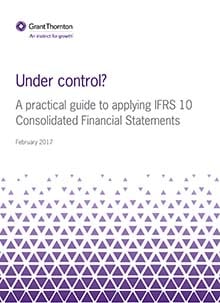-
Sector Focus
We specialise in the investment management industry offering audit, assurance, tax and corporate recovery and liquidation services.
-
Personal Tax Services
There are many tax rules that can affect you personally and therefore which will have an impact on your personal wealth.
-
QI Compliance
Qualified Intermediaries (QI) have to take action now to perform a Certification to the Internal Revenue Service (IRS).
-
Download our tax brochures
The tax teams at Grant Thornton aim to provide the Channel Islands with a premier tax advisory service both to private clients and the business community including the investment management industry.
-
Jersey Tax Return
A secure sign in page to file Jersey Tax Returns through the Grant Thornton tax portal.
-
ESG
ESG can either be seen as a risk management tool or an opportunity, either way it is imperative to your business, whatever your size and whether you are listed or not.
-
Professional Services
Business and accounting support for professional services
-
Finance Industry
We work with a broad range of clients and their financial stakeholders, from entrepreneurs in the early days to fast growing and established businesses to public companies competing in global markets.
-
Local Businesses
Businesses come in many shapes and sizes – from innovative start-ups to long-established local businesses. But however large or small your business, the chances are you face similar challenges.
-
Corporate Insolvency
Our corporate investigation, Guernsey liquidation and recovery teams focus on identifying and resolving issues affecting profitability, protecting enterprise value and facilitating a full recovery where possible.
-
Corporate Simplification
Redundant corporate entities can over complicate group structures and waste thousands of pounds in unnecessary costs each year. 46% of the c.15,500 companies controlled by the FTSE100 are dormant and it is estimated that the average cost of administering dormant companies is between £3,500 and £5,000 per company, per year.
-
Debt Advisory
Our Debt Advisory team provides commercial and financial debt advice to corporate entities and public sector bodies in a range of sectors. Our engagements include advice on stand-alone transactions and solutions or as part of an integrated business plan, in both the project and corporate arenas.
-
Exit Strategy Services
We offer a tailored methodology designed to enable a company to be reviewed in a group context to assess ways to maximise its value.
-
Financial Restructuring
For companies challenged by under-performance we work with management teams, shareholders, lenders and other stakeholders to implement financial restructuring solutions creating a stable platform for business turnaround.
-
Strategic performance reviews
Strategic performance reviews analyse the key drivers of performance improvement. Our specialists utilise a framework to evaluate financial and operational options and to identify solutions for businesses and their stakeholders.
Assessing when one entity controls another (in other words, when a parent-subsidiary relationship exists) is essential to the preparation of financial statements in accordance with International Financial Reporting Standards (IFRS). The control assessment determines which entities are consolidated in a parent’s financial statements and therefore affects a group’s reported results, cash flows and financial position. Under IFRS, this control assessment is accounted for in accordance with IFRS 10 ‘Consolidated financial statements’.
IFRS 10 redefines ‘control’
IFRS 10 was issued in May 2011, and was part of a package of changes addressing different levels of involvement with other entities. IFRS 10 redefines ‘control’ and provides extensive guidance on applying the definition.
It is unusual for IFRS 10 to affect the scope of consolidation in simple situations involving control through ownership of a majority of the voting power in an investee. However, more complex and borderline control assessments need to be reviewed carefully.
Consistent application of IFRS
We have gained extensive insights into the application of IFRS 10 and we have developed general guidance that supports the commitment to high quality, consistent application of IFRS. We are pleased to share these insights by publishing ‘Under control? A practical guide to applying IFRS 10 Consolidated Financial Statements’.
The guide has been written to assist management in applying IFRS 10. More specifically it aims to assist in:
- understanding IFRS 10’s requirements
- identifying situations in which IFRS 10 can impact control assessments
- identifying and addressing the key practical application issues and judgements.

